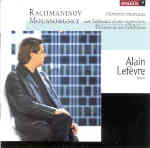Alain Lefèvre’s clean fingerwork and crystalline sonority give the labyrinthine, orchestrally inspired textures of Rachmaninov’s Moments Musicaux a quality we might liken to a newly bathed and scrubbed-down lion. You get a shiny mane and a proud strut, but with a purr in place of a roar, and a docile, even-handed temperament where ferocity once dwelled. Hear, for instance, how Lefèvre carefully rounds No. 2’s incisive edges and domesticates its wild, swirling passagework. Then pull down Vladimir Horowitz’s galvanizing, fearless version, and the piece transforms from a pretty etude into Russian soul music. Where’s the dark, brooding lyricism others bring to No. 3? Not here.
In Pictures at an Exhibition, Lefèvre takes Mussorgsky’s opening Prelude at a heavy, loping crawl that has little to do with the composer’s Allegro giusto marking. Gnomus is static, notey, and utterly lacking in mystery, while the pianist’s slight phrase broadenings make The Old Castle sound slower than it is actually played. The scurrying patterns of Tuileries, the Limoges Marketplace, and the Ballet of the Unhatched Chicks are prosaically dispatched compared to the supple fluency and character you hear from Kissin, Ashkenazy, Richter, and Berman. When Lefèvre arrives at Kiev’s great gate, he finally plays with affirmation, individuality, and a true sense of the music’s cumulative power. But is a fulfilling climax worth a tedious journey through the preceding movements?
































